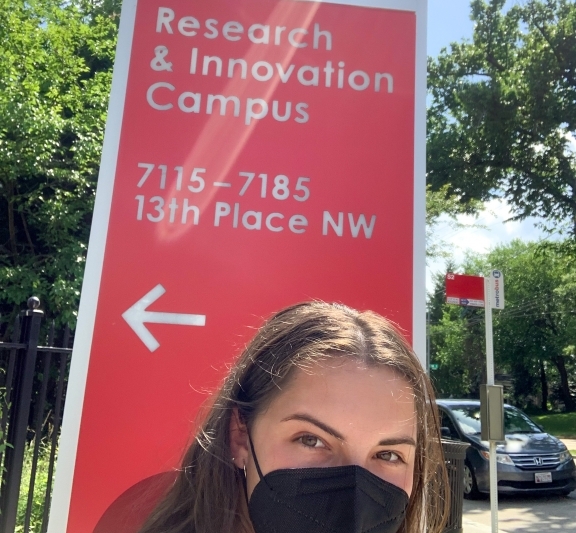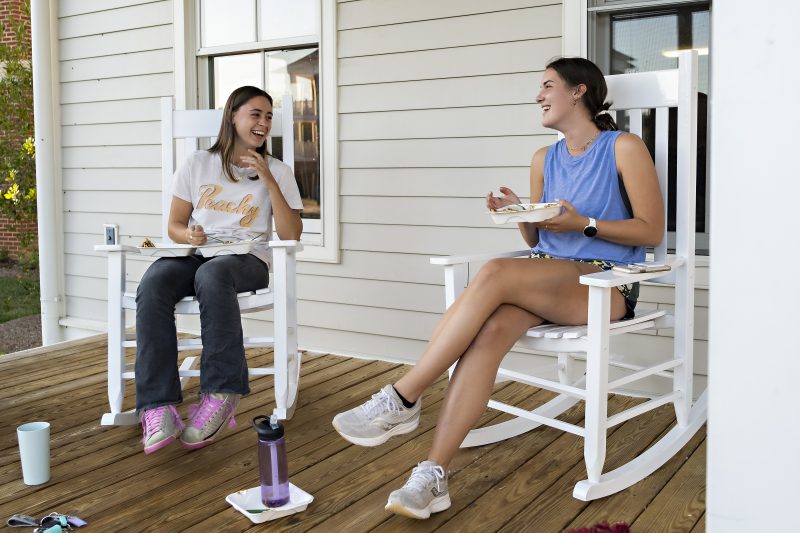Stepping Stones in STEM Bonner Kirkland '23 conducted biomedical research this summer in the Children’s National Hospital’s Department of Genetic Medicine.
“Being able to see and experience the direct patient impact of this research has been incredibly rewarding, and further inspires me to pursue a career within the biomedical field.”
~Bonner Kirkland ’23
Name: Bonner Kirkland ’23
Hometown: Nashville, Tennessee
Major: Engineering Integrated with Biology
Q: What factors led you to choose W&L?
I was immediately drawn to W&L by the strong sense of community on campus, as the honor system and speaking tradition reinforce a sense of trust and camaraderie among students and faculty. I was also drawn to the small class sizes, which I’ve found to be extremely valuable to my learning process. I knew I wanted to pursue a science, technology, engineering and mathematics (STEM) major, and that being able to work in smaller groups of students closely alongside professors would greatly facilitate my ability to learn and develop skills that can be applied later in life. W&L’s strong alumni network was also very appealing to me, and the ability to connect with and seek career advice from alums is another valuable aspect of our community.
Q: Why did you choose your course of study?
I knew I wanted to pursue a major within the STEM field when I arrived at college, but was undecided on what specific topics I was interested in. After taking Physics I in my first semester with Professor Irina Mazilu, I immediately fell in love with not only the subject matter, but also the Physics and Engineering Department. Each of the professors in this department genuinely care about their students’ growth, both in and outside of the classroom. They constantly volunteer their time to ensure students reach mastery of the difficult subject matter. My love for problem solving, math and science — partnered with wonderful professors — prompted me to pursue an engineering major. I’ve thoroughly enjoyed the engineering coursework I’ve taken which has exposed me to a variety of engineering topics, from electrical circuits to fluid mechanics.
The ability to integrate the engineering major with another science discipline — in my case, biology — enabled me to take a variety of biology courses in addition to engineering classes. I’ve always wanted to pursue a career within the medical field, specifically biomedical engineering, so this major has allowed me to supplement my engineering skillset with biological knowledge that will help me in the future.
Q: How did you find out about this opportunity? Did anyone at W&L help?
I briefly worked in the same lab through a program offered by my high school in 2018. Knowing I wanted to pursue a medical research position this summer, I reached out to my previous lab supervisor to see if he had any open positions for student research and he graciously welcomed me back into his lab. Because this is an unpaid position, this experience was made possible entirely through the generosity of W&L donors and summer funding opportunities, particularly the Johnson Opportunity Grant, Department of Physics and Engineering’s supplemental summer funding, and Career and Professional Development funding. I am incredibly grateful for financial support from both the school and generous donors, allowing me to pursue this research position by offsetting the costs of living and working in Washington, D.C.
Q: What kind of work are you doing?
This summer I conducted research in the Children’s National Hospital’s Department of Genetic Medicine, where we are working on developing a quicker and more cost-effective method for determining abnormalities in amino acid concentrations in newborns. Traditional methods for evaluating amino acid concentrations in patients have been costly, timely and often require a large volume of sample. The method we are developing, on the other hand, requires a small sample and allows for the quick and proactive diagnosis of various genetic conditions in newborns marked by unique amino acid levels.
We are also working on a project to evaluate how glutathione, a combination of three amino acids, works to relieve cellular damage caused by oxidative stress in cells. Glutathione acts as an antioxidant defense against oxidative stress, preventing damage to the cells. This project will reveal how glutathione may work as an anti-aging mechanism that strengthens the immune system, detoxifies the body and eliminates carcinogens. All summer, I have been maintaining, growing, and plating HepG2 cells, then treating them with various concentrations of hydrogen peroxide to cause oxidative damage. Then I either pre- or post- treat these cells with gamma-glutamylcysteine — a precursor amino acid to glutathione — and analyze how this facilitates cell recovery. This work requires close attention to detail and sterile technique as to not contaminate the cells.
Q: What do you like most about it, and what has been most challenging so far?
Having the opportunity to work with patient samples has definitely been a highlight of this internship. Recently, through use of this new method, researchers in the lab noticed that patients suffering from sickle cell anemia had low levels of citrulline, a critical amino acid which regulates vasodilation. These low levels of citrulline cause vasoconstriction — and thus, we hypothesize — chronic pain. After administering a dose of citrulline to several patients suffering from severe pain, they reported significantly reduced pain levels. The prospect of being able to use a naturally occurring amino acid rather than morphine to mitigate pain in these young patients is extremely valuable. Being able to see and experience the direct patient impact of this research has been incredibly rewarding, and further inspires me to pursue a career within the biomedical field.
I have also enjoyed being able to work on a project of my own, analyze the data and present my findings. The glutathione project I’m currently working on has been challenging, confusing and frustrating at times, particularly when the data comes out differently than expected. However, it has taught me that research is rarely clean cut and perfect on the first try. It takes frequent repetition and minor tweaking of procedures to yield the desired results. Towards the end of the summer, I was able to present my results in our department’s lab meeting, which was an exciting and meaningful experience. Sharing the culmination of my summer’s work with people working in different labs allowed me to gain more experience giving scientific presentations to people of different backgrounds.
One of the most difficult elements of this research experience has been having to quickly familiarize myself with complex biochemistry and genetic topics. The majority of my coursework focuses on standard engineering classes and some biology classes, whereas this research is heavily based in chemistry. Becoming familiar with the different chemical and biological pathways involved in this project has definitely been a steep learning curve. However, I make up for my lack of prior chemistry coursework by reading relevant literature to the project and papers this lab has published in the past, as well as actively communicating any questions I have with my lab supervisor.
Q: Tell us about previous summer experiences you’ve had at W&L.
Last summer, I worked as a compliance engineer intern for TVP Health, formerly known as The Ventilator Project. This nonprofit organization was founded in March 2020 in response to the COVID-19 pandemic with the mission of ensuring all people have access to quality medical care amid a global ventilator shortage. TVP Health developed a lower-cost ventilator, called AIRA, to combat this global issue. As a compliance engineer, I worked to ensure AIRA met various ISO medical device standards. This initial exposure to the medical device industry piqued my interest in the field and prompted me to consider a career path in biomedical engineering, as the intersection between engineering and direct patient impact is very important to me.
Q: How do you think your current summer experience – and others you’ve had in the past, if applicable – will impact your future career path?
I have been interested in the sciences and problem solving for as long as I can remember, but my passion for integrating medicine with engineering began through my aforementioned internship with TVP Health. Last summer’s experience dealt with the more technical, regulatory side of the medical device industry, so I have really enjoyed this summer’s research, as it pertains more to the hands on, biological side of medical research. Gaining exposure to these two aspects of the industry will be incredibly formative in my future career endeavors.
My research experience at Children’s National Hospital immersed me in the field of biomedical research. I was given the opportunity to learn and practice sterile lab technique, the scientific method and the problem-solving methods used in the scientific world. This internship has also taught me the importance of communication with coworkers and superiors, as well as how to proactively avoid problems in a lab setting and think critically to respond in unfamiliar situations. After graduation, I hope to pursue a master’s degree in biomedical engineering, and everything I have learned from my summer experiences will be incredibly valuable throughout graduate school and beyond.
I hope to focus my skillset on the medical device industry, particularly within the realm of women’s health and medicine. Women are often underrepresented in clinical trials due to the complex, variable female hormone system. This can lead to women being misdiagnosed and prescribed the wrong medication, resulting in further health complications because women may react differently to a medication or medical device tested in a predominantly-male clinical trial. This injustice inspires me to develop female-centered medical devices and treatment methods, and I believe my current research opportunity is an early steppingstone to the field of medical research for me.
Q: Outside of your internship, what have you enjoyed the most about living and working in Washington D.C.?
One of my favorite parts about Washington D.C. is the walkability of the city and the access to public spaces. In my free time, I’ve loved going to Smithsonian museums, walking on the National Mall, going to the farmers market, and running in Rock Creek Park. I especially loved visiting the National Arboretum and seeing their current Ikebana exhibit. I’ve learned that having access to quality outdoor spaces is something that is a very important factor to me when choosing a city to live in after graduation.
Q: What do you miss most about W&L when you’re away for the summer?
While being in a bigger city is exciting and lively, I definitely do miss W&L when I’m away. Living on a small, welcoming and safe campus like ours is something I often take for granted during the academic year. The sense of community on campus is one of my favorite parts about being a W&L student. Having time away from school makes me grateful for aspects of our community like the honor system and speaking tradition, which unfortunately are not as prevalent in other places. I also miss the day-to-day interactions with people on campus, whether its grabbing lunch at Café 77 with a friend or catching up with a professor between classes.
If you know any W&L students who would be great profile subjects, tell us about them! Nominate them for a web profile.
 Bonner Kirkland ’23 and her lab supervisor, Dr. Gary Cunningham
Bonner Kirkland ’23 and her lab supervisor, Dr. Gary Cunningham Bonner Kirkland ’23 in front of the Children’s national Hospital in Washington, D.C.
Bonner Kirkland ’23 in front of the Children’s national Hospital in Washington, D.C. Susannah Birle ’23 and Bonner Kirkland ’23 enjoy a meal on their porch in Third-Year Housing.
Susannah Birle ’23 and Bonner Kirkland ’23 enjoy a meal on their porch in Third-Year Housing.
You must be logged in to post a comment.